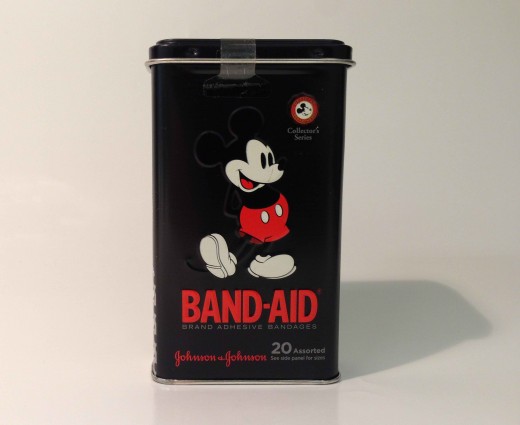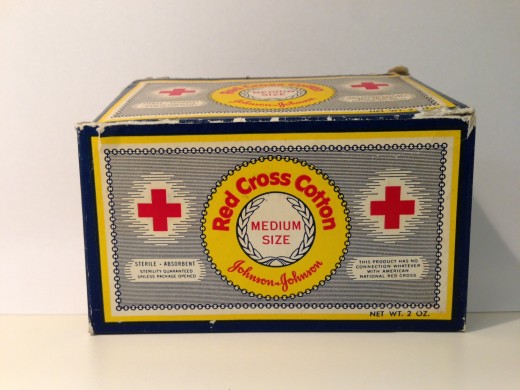Recent Acquisitions and a Mystery!
One of the most amazing things about Johnson & Johnson history is the connection that people feel to it – employees, retirees, people whose ancestors worked for Johnson & Johnson, and people who grew up with our iconic BAND-AID® Brand Adhesive Bandage tins, First Aid Kits, and other familiar products. Since the company has been around since 1886, there are a lot of Johnson & Johnson artifacts out there. Many people are kind and generous enough to send things to us, which we make part of our archives and Museum. These donations – and the emails and letters that accompany them -- are part of the ongoing conversations that Johnson & Johnson has been having with people for more than 100 years. So here’s a look at some recent acquisitions that were donated to our Museum and archives, along with a very mysterious mystery item.

This historic LISTERINE® bottle was sent to us by a gentleman from Virginia. The bottle, which dates from around the turn of the 1900s, was discovered at the site of a blacksmith’s shop and home near Reedville, VA. The bottle originally would have had a cork stopper. LISTERINE® Antiseptic was first formulated in 1879 as a surgical disinfectant named in honor of Sir Joseph Lister, the father of modern antiseptic surgery. Around 1900, the product was still used by consumers to help disinfect small wounds, and the fact that it came from a blacksmith’s shop means that the owner probably used it both as a mouthwash and to help keep small cuts clean.

This beautiful First Aid Autokit was sent in by H.T., an employee. The kit dates from the 1930s, and it comes to Johnson & Johnson at a very appropriate time, because this year is the 125th anniversary of Johnson & Johnson making the first commercial First Aid Kits in response to the need to treat injured railroad workers back in 1888.

The Autokit is in great condition, and it still retains its contents, including an Esmarch Triangular Bandage, a famous first aid product whose origins date back to 1870. It was donated with a Johnson & Johnson First Aid Compact Kit – also with its contents – from the 1970s.

This incredibly cool BAND-AID® Brand Adhesive Bandages tin was recently donated to our archives by a group that does a lot of work with Johnson & Johnson. Not only is it a rare re-issue tin, but it has a very familiar character on it.

This beautiful JOHNSON’S® Baby Cream jar was donated to us fairly recently. An example of highly collectible milk glass, this product was in countless households...and in the household of the person who donated it. This one survives with both its front and back labels intact.

Not everything that gets donated to our Museum is a tin or a bottle. These decades-old examples of RED CROSS® Bandages were donated to us from someone in Pennsylvania, and are in perfect condition. They arrived with a box of our famous RED CROSS® Cotton.

Johnson & Johnson was the first company to make cotton sterile, white and absorbent back in 1887; before that, doctors and surgeons used it despite the fact that the plant’s natural oils made it useless as an absorbent dressing, and despite the fact that it was generally full of dirt and other plant materials. We also pioneered wrapping the sterile cotton in blue paper. Many people grew up with this familiar box in their family’s medicine cabinet.

Johnson & Johnson pioneered mass produced women’s sanitary protection products back in 1897, and it remains one of our oldest continuous businesses today. In the 1920s, the MODESS® Brand pioneered silent purchase coupons, an innovative way to market a product in an era when it was difficult to talk about that particular product. MODESS® also created one of the top 100 advertising campaigns of the 20th century. This gorgeous but fragile vintage box of MODESS® from the early 1930s was recently donated to our Museum and archives by colleagues at our consumer operating company.

This rare copy of “But, General Johnson –“, written in 1944 by General Robert Wood Johnson, was donated to us by a Johnson & Johnson employee. Not only is it a rare book, it has General Johnson’s signature on the flyleaf in the front. How cool is that!

General Robert Wood Johnson wrote a number of books, pamphlets and articles during his career, and he was one of the first business leaders to write about the social responsibilities of business. “But, General Johnson –“ is notable for the early inclusion of Our Credo in the book, under the title “An Industrial Credo,” (because Johnson felt that all of American industry should adopt those business principles). The book details Johnson’s experiences as head of the Smaller War Plants Corporation in Washington, D.C. during the 1940s, and he said that the title came from the phrase heard the most whenever he came up with a new idea.
Along with vintage products, books and other items, people also donate stories to us. Some of the stories that people have shared take us all the way back to 1888, and they include stories about how our salesmen in 1921 had to demonstrate how to use BAND-AID® Brand Adhesive Bandages because they were the first product of their kind; a story about the mom who had the idea for duct tape as a way to save soldiers’ during World War II; and stories passed down from New Brunswick, New Jersey’s historic Hungarian community – many of whose members worked for Johnson & Johnson a century ago. If anyone has a story to share from Johnson & Johnson history, we’d love to hear from you!

Finally, here’s a very puzzling historical mystery. This mysterious item was donated by an employee who’s a Kilmer House reader and a huge fan of Johnson & Johnson history. It’s a clear, molded glass, er... something that measures a little under five inches in diameter. It stands about 2 ¾ inches tall and consists of an upper round portion on a round stand. The underside of the top section has a lip, and the glass on the underside of that lip is etched or scored. The object is embossed on the outer rim with: “Johnson & Johnson, New Brunswick, N.J. U.S.A.”

It has a three-part division in the center of the top, and as an item it’s functional rather than decorative.

Was it an item for retail pharmacists? Was it meant for use inside Johnson & Johnson? Or was it just the world’s smallest cupcake plate for three different kinds of incredibly tiny cupcakes? What was it? We don’t know, and we’re hoping that someone can tell us! If you have an idea of what our mystery item is, or think you know what it might be, please let us know in the comments section of this post, or through the blog’s email at [email protected]. I’ll publish the answers on the blog!

I have an almost identical bottle of the Listerine bottle image that you posted with the name embossed on the bottle. However, mine still has front and back label and a screw cap. Would you like me to send an image somewhere and you can see if you would be interested in receiving the bottle itself. Front Label states: Listerine Antiseptic... Kilss Germs by Millions on Contact.... For Bad Breath, For sore Throats due to Colds. On the Back It provides more details in English and French as it is a Canadian bottle made by Warner-Lambert Canada Ltd. It is a 7 Fluid Ounces bottle. Thanks, Karen.
Hi Karen,
I would love to see an image of your LISTERINE® bottle. From your description of the bottle having a screw cap rather than a cork, it sounds like your bottle is post-1920s. I would definitely be interested in adding your bottle to our Museum and archives if you’re willing to donate it. It would be the first dual-language LISTERINE® bottle in our collection.
Thanks!
Margaret
I have just stumbled across this site and am so excited. I worked for J&J Consumer Products from 1983-89. I offices in Kilmer House. I was there during the Tylenol scare. I was one of hundreds that volunteered to work the phones. I have never been more proud of how it was handled. Still have my J&J stock. Many great memories. Loved the company store too!
The JNJ mystery: Might you be assuming which is the top and which is the bottom? Most company emblems are on the bottom of things. Might the bottom (what you have called the top) be sectioned into 3 parts to better hold it? Is the top (your bottom) concave? Your thoughts on this?
I believe the mystery item was used for displaying J&J products =-).
@Terri,
I’m glad you found Kilmer House, and thanks for sharing your memory of such a momentous time at Johnson & Johnson.
Margaret
@Diane,
The bottom is flat with a very small concavity in the center. As you can see from the pictures, the top part is the part with all of the details and features, and the bottom is very plain and looks like it’s just a base. It is possible that the mystery item could be upside down, but that would mean that it would need to fit into something else in order to stand, since the top sticks up and it would not be able to balance otherwise. The mystery deepens!
Margaret
@Nathaniel,
Anything’s possible! They would have to be very small products, though! :-)
Margaret
How tall is the stem separating the top from bottom sections? Might it have been used a holder for sterile gause dressing strips similar to a tape dispenser with this "top" fitting into a glass bottom (etching and lip hint at a glass on glass seal simlilar as to what might have been seen on old apothocary jars)?
Wayne,
The stem separating the top from the bottom is 1" tall. It's very possible that it's one part of a multi-part item, such as a holder for sterile gauze or dressings (or even sterile professional dental gauze products, which the Johnson & Johnson Family of Companies made at one time!) The etching and the lip do indeed hint at a glass on glass seal!
Margaret
Dears,
The edge of the mystery seems have a specific profile and for me the mystery loose his cover !
The glass of the mystery seem very thick and strong, not really designed to be a "Nice" object.
For me , this mystery could have is place in a laboratory.
I noticed the shape in the middle of the mystery,
I think about something like a dessicator, even it's a bit flat for that, and even i don't see why 3 compartments!!!